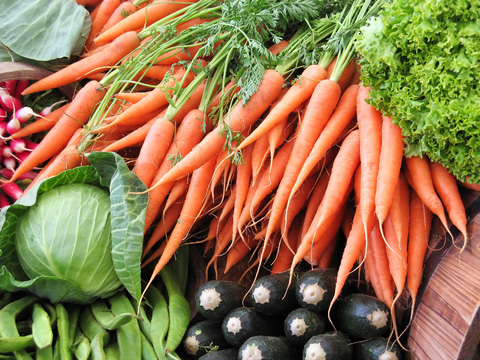How the Pickiest Pick Produce
Of course, today’s supermarkets have already narrowed your fresh fruit and vegetable choices for you—and you don’t have to worry about such nuisances as weevils or borers in the produce on most grocery shelves. Just about anything you buy will be uniform and good quality. but there are ways to choose the tastiest of what’s […]

Of course, today’s supermarkets have already narrowed your fresh fruit and vegetable choices for you—and you don’t have to worry about such nuisances as weevils or borers in the produce on most grocery shelves. Just about anything you buy will be uniform and good quality. but there are ways to choose the tastiest of what’s available, whether from your garden, a farmers’ market, or the grocer’s shelves. Here are words of wisdom from Amelia Simmons, author of American Cookery (1798), that still hold true in this day of hybrid technology and flashfrozen products.
Use the ruler for carrots.
When you
want big chunks of carrot for stew or
need grated carrot for cakes or muffins,
you can’t rely on those convenient
prepeeled baby carrots; you need bigger
roots. If you rarely buy full-size carrots,
remember that they’re not all created equal. Be sure to choose carrots that are
“middling siz’d, that is, a foot long and
two inches thick at the top end.” Their
flavor and sweetness is “better than overgrown
ones,” but they’re large enough to
work with easily.
See red for slaw.
If you’ve got a food processor and want to try your hand at
home-shredding cabbage for slaw, try red
Savoy cabbage. The reddest of the small,
tight heads are best for slaw, claims
Amelia Simmons. But don’t try to cook
any leftover cabbage, she warns. “It will
not boil well, comes out black or blue,
and tinges other things with which it is
boiled.”
Pick the pudgy parsley.
Whether you’re making a selection from your own herb
garden or the produce section, look for
“the thickest and branchiest” parsley for
the fullest flavor. “The best-tasting parsley
is always growing vigorously and getting
enough water, so it won’t be straggly
or yellow,” says Rose Marie Nichols
McGee, co-owner of Nichols Garden
Nursery, in Albany, Oregon. “And if
you’re picking parsley from your garden
or a window box, you should pick from
the center, but not just because it’s thickest
there.”Picking parsley from the center
on a regular basis prevents the plant from
bolting (producing a seedstalk). Plants
that bolt may have an off flavor, Rose
Marie explains.
My watermelon is like a red, red rose. In American Cookery (1798), Amelia Simmons advises readers to choose redcored watermelons, since they are “highest flavored.”And this is easy to do these days, since grocery stores and farmers’ markets often sell cut halves and slices of watermelon—you don’t have to wait to get home and cut your melon open to see what you’ve got. As for selecting the best uncut melon, Leslie Coleman, director of communications for the National Watermelon Promotion Board, suggests that there is a more reliable method than the proverbial thump. “Select a firm, symmetrical watermelon that is free of bruises, cuts, and dents. Turn the melon over. If the underside is yellow and the rind has an overall healthy sheen, the watermelon is probably ripe. Select melons that are heavy for their size.”


